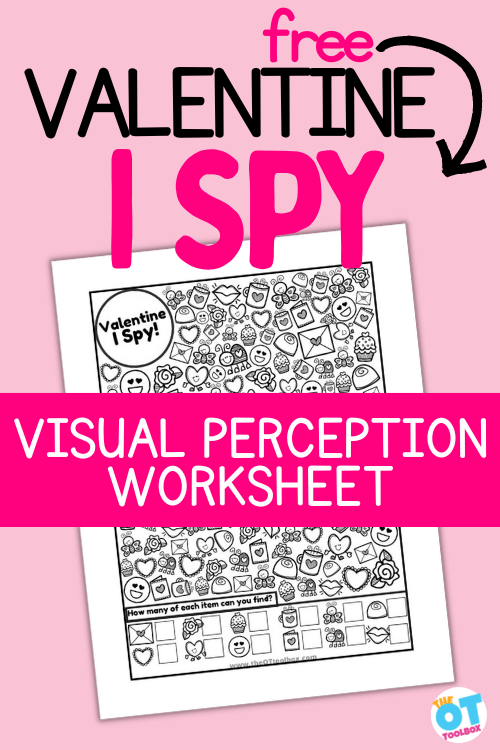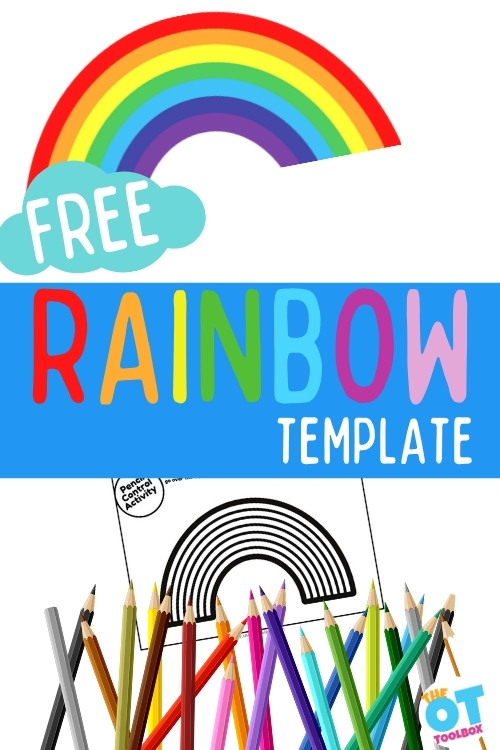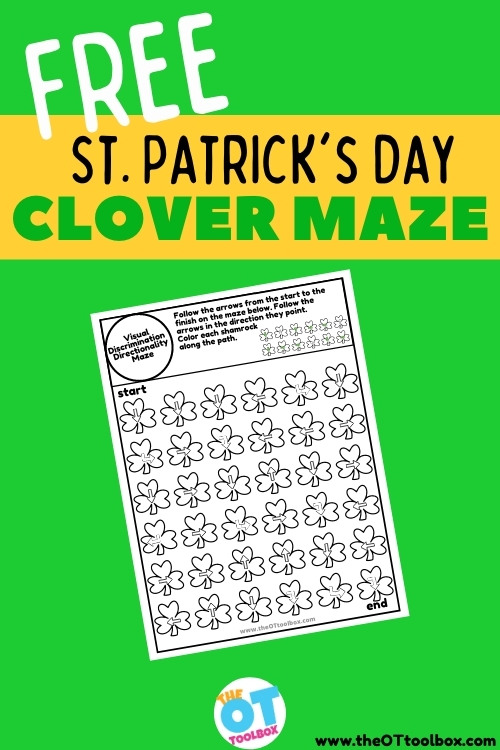This Valentines Day I Spy is a fun activity for developing skills in visual perception, eye-hand coordination, and more. Add it to your collection of Valentine’s Day occupational therapy activities for a fun way to build skills!
Can you believe it is Valentine’s day already? Although this is considered a “greeting card” holiday made up for the benefit of selling products, children LOVE sending and receiving Valentines.
Just in time for the big day, the OT Toolbox is coming to your inbox with this free Valentine I Spy worksheet!

Valentine I Spy Free Download
What is better than Valentine’s day? Something free! Input your email address below and your Valentine I Spy PDF will be zoomed to your inbox. Better yet, become a member of the OT Toolbox and save the hassle of entering your email address each time. Membership has its perks. Extra resources not in the “free” section, member only downloadables, and themed sections with similar resources all in one place.
Fun Facts about Valentine’s day
- Americans spent over 27 billion dollars on Valentines gifts in 2020
- Americans send 145 million Valentines cards each year
- One idea states in the middle ages Valentine’s day was created because it was the start of mating season
- Legend says Valentine was killed for attempting to free prisoners, sending letters to the recipient signed, “from your Valentine”
- Over 27 million Americans sent Valentines to their dogs in 2020
- Nearly six million couples get engaged on Valentine’s day
How to use the Valentine I Spy worksheet
As always, the Valentines Day I Spy activity is designed to e used in a variety of ways to meet the needs of different levels of learners.
- Laminate the page for reusability, or use a simple page protector. This saves on resources, and many learners love to write with markers! Note: while some learners love to use wipe off sheets, others become upset they can not take their work with them. For those who want to save their work, consider taking a screenshot of it.
- Create a notebook of resources stored in page protectors for use each year
- Slide the printable into a page protector sleeve and use dry erase markers to color in or circle the hidden objects
- Make this part of a larger lesson plan including gross motor, sensory, social, executive function, or other fine motor skills
- Talk about Valentine’s day, talk about the pictures in the worksheet, discuss traditions and expectations for the holiday
- Enlarge the font for beginning learners who need bigger space to write, or have below average visual perceptual skills
- Project this page onto a smart board for students to come to the board
- More or less prompting may be needed to grade the activity to make it easier or harder
- Block of certain areas of the Valentine’s I Spy page to help learners focus on one part at a time
- Use different tools to mark the page. Bingo markers, Bingo chips, markers, crayons, pompoms, play dough, or a finger if you want to remove the fine motor element of the task
- Learners can explore other games they could make using this activity
- Write a report about Valentine’s day, types of Valentines, the history of the holiday, different celebrations, or activities
- Executive function – hand the papers out with very limited instruction. Record how well your learners can follow instructions without repeat guidance
- Have students write on a slant board, lying prone on the floor with the page in front to build shoulder stability, or supine with the page taped under the table
Visual Perception and the Valentine’s Day I Spy Printable
I Spy printables are great for building visual perceptual skills.
Visual perception refers to the brain’s ability to make sense of what the eyes see. This is different from visual acuity which is how clearly a person sees. A person can have 20/20 visual acuity and poor visual perceptual skills.
Visual perception is important for everyday activities like puzzles, math, finding the right cereal on the shelf, dressing, reading, cutting, and about a million other necessary skills. Visual perception is made up of seven different areas. The ones targeted in the Valentine’s Day I spy activity are:
- Visual Attention: The ability to focus on important visual information and filter out unimportant background information.
- Visual Discrimination Skills: The ability to determine differences or similarities in objects based on size, color, shape, etc.
- Visual Memory: The ability to recall visual traits of a form or object.
- Visual Figure Ground: The ability to locate something in a busy background.
- Visual Form Constancy: The ability to know that a form or shape is the same, even if it has been made smaller/larger or has been turned around.
How to Use the Valentine’s day I Spy Worksheet
This, like any activity can be a stand alone task. It can also be grouped into a specific theme.
- Visual perception – group several different visual perceptual exercises and games together to focus on this skill.
- Valentine’s day theme – The OT Toolbox has a huge range of activities centered around Valentine’s day
- Sensory tools – make Valentines sensory bins, sensory bottle, finger paint crafts, or obstacle courses
- Valentine’s Fine Motor Kit – address several different fine motor skills in one fun print and go deal
- Use this Valentine’s Day activity in a classroom party, as a fun activity for the classroom , or in therapy sessions leading up to Valentine’s Day.
- Use this activity for different ages: Preschoolers can color the items they find. Middle school kids and high school kids can write about the objects hidden in the puzzle.
- Work on early math skills with younger children. Add up the items hidden in the free printable game. Can they add up certain items to create Valentine math problems using picture symbols? Create Find the of correct number of items for each object.
- Build coloring skills. Assign a color for each hidden object. Then use the activity as a color worksheet with hidden pictures. Children can place a colored bead or other marker on the graphics that match.
- Use the activity as printable games to build skills. Working with a small group, users can race to find the hidden objects.
- Challenge fine motor skills by asking the child to place heart candy on certain objects hidden in the I spy activity.
- Add the activity to our other Valentine’s Day printables here on the site.
- Encourage creativity: Ask users to color in all of the similar items with a certain color, or focus on finger isolation to place a fingerprint on all of the matching objects.
- Build scissor skills, precision dexterity, and eye-hand coordination. Print off one copy and cut out the images at the bottom of the page. Then, present the user with a copy of their own. They can place the matching objects on the items they find in the valentine’s day printable.
This is a great activity for so many skill areas!
My personal favorite is the fun and interesting facts and legends surrounding this holiday. Who knew it started hundreds of years ago? Whether you are in it for the flowers and chocolate, hoping to get engaged, or spending some time with loved ones, use this holiday as a reason to create fun and engaging games and activities to help your learners.
Free Valentine’s Day I Spy
Want to add this printable worksheet to your themed items for Valentine’s Day fun? Enter your email address into the form below. Or, if you are a Member’s Club member, you can find this PDF file inside the membership under Valentine’s Day Therapy Theme (Level 2 members) or on the freebie dashboard under Vision Tools (Level 1 and Level 2 members).

Victoria Wood, OTR/L is a contributor to The OT Toolbox and has been providing Occupational Therapy treatment in pediatrics for more than 25 years. She has practiced in hospital settings (inpatient, outpatient, NICU, PICU), school systems, and outpatient clinics in several states. She has treated hundreds of children with various sensory processing dysfunction in the areas of behavior, gross/fine motor skills, social skills and self-care. Ms. Wood has also been a featured speaker at seminars, webinars, and school staff development training. She is the author of Seeing your Home and Community with Sensory Eyes.




